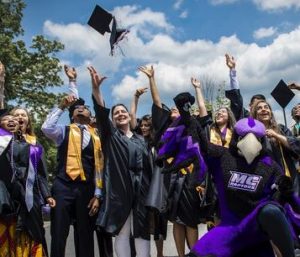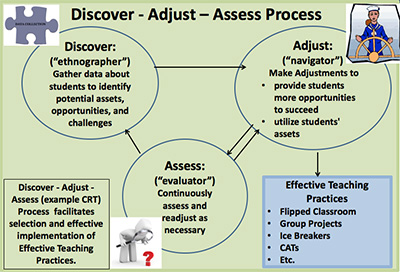
Across U.S. higher education, the instructor faces the challenge of teaching the course’s learning outcomes, content, and skills to an increasingly diverse student population in a limited amount of time. Reaching these students will increase the chances that they will persevere and succeed in their college studies. But how can this be done both effectively and efficiently?
One simple approach, illustrated in this diagram, is to first learn about one’s students by playing the role of an ethnographer.

Through surveys and classroom assessment techniques (CATs), instructors can identify which factors may have (be having) a significant impact on the learning of the class, as a whole, as well as individual students within that class. These factors go beyond ethnicity and may include gender, age/generation, work-family situations, and previous learning experiences. For example, survey results may show that a majority of students in one’s class may lack confidence as a result of negative learning experiences or poor results in the pre-requisite course.
The next step is to use this information to guide the class, as a pilot or navigator, to success by making adjustments to instruction. For example, in the case mentioned above, the instructor might build students’ confidence by providing additional scaffolding (support) for assignments or administering daily or weekly low-stakes quizzes before each unit test. After each adjustment, the instructor will ideally assess its effectiveness through additional surveys and CATs.
This approach or process is based partly on the following definition of culturally responsive teaching (CRT): “using the cultural knowledge, prior experiences, frames of reference, and performance styles of ethnically diverse students to make learning encounters more relevant to and effective for them” (Gay 31). In following this process, instructors will also demonstrate to their students that they care about them and their learning, which may have additional positive impacts on students’ success, and, perhaps more importantly, their perceptions of the learning process as a whole.
Gay, Geneva, Culturally Responsive Teaching: Theory, Research, and Practice, 2nd Ed. New York: Teachers College Press, 2010. Print.
See these additional resources for Culturally Responsive Teaching:
- Recording from 2017 Faculty Showcase on Culturally Responsive Teaching: https://www.youtube.com/watch?v=lTwMmBgYkng
- Five Minute Faculty Development videos for Culturally Responsive Teaching: https://mcblogs.montgomerycollege.edu/thehub/faculty-spotlight/five-minute-faculty-development/culturally-responsive-teaching/
